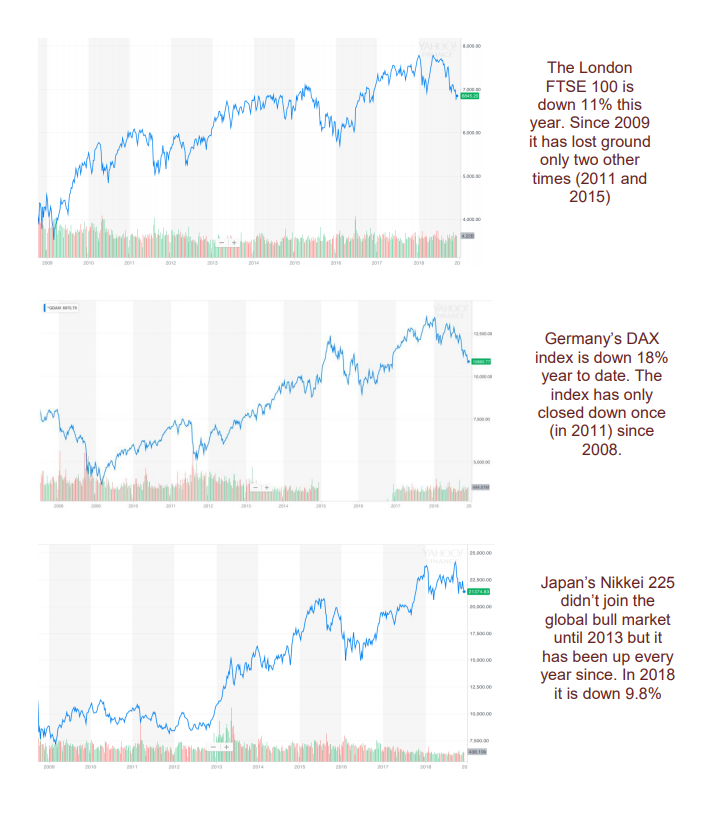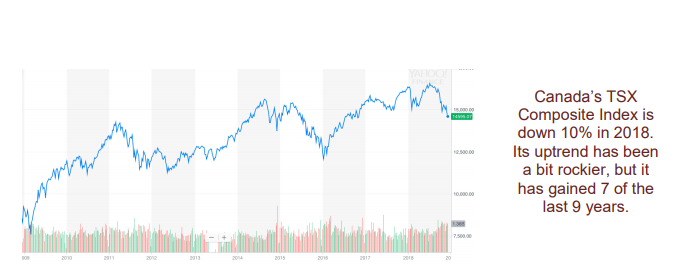
Gwen Preston – “If Powell Pauses…Metals Will Perform”
There’s one issue that matters more than the rest in the macroeconomic world right now, and it’s a specific one.
What will Jerome Powell say on Wednesday?
Powell is the chair of the Federal Reserve. The US central bank’s core committee meets next Tuesday and Wednesday to decide what to do about interest rates, and then Powell will announce the result of that discussion.
The Fed has been on a tightening path for almost three years now. After years of keeping rates ultra low to stimulate the economy after the financial crisis, the Fed enacted its first raise 2 in December 2015. In the three years since it has raised 7 more times, bringing the Federal Funds rate to 2.25%.
And even as recently as the last Fed rate decision, in October, Powell spoke of staying on track – continuing to raise rates every few months until they reached ‘neutral’, which means a rate that neither encourages nor discourages borrowing and growth.
But a lot has changed since October.
US stock markets peaked for the year early that month and have fallen more than 10% since, putting them in correction territory..
US markets are not the only ones sliding. In China, Japan, across Europe, in Canada – markets are down for the year. That’s notable: many of these markets haven’t closed the year down since this bull market started eight years ago.
As I write, global markets are sliding. Again. Powering Friday’s slide were a list of reasons that really apply to the whole year. Last week we got weak economic data from China and Europe, which bolstered worries about global growth. Of course, such worries have been rising for months on trade war uncertainties.
The thing about the trade war is that no one yet has any idea what’s really going to happen. Right now China and America are making goodwill gestures: China is buying boatloads of soybeans and suspending an additional 25% tariff on US vehicles and auto parts that was supposed to start January 1, for instance. But given that Trump and Xi seem to have left their G20 meeting with very different ideas about what they had even discussed, no one has any confidence that today’s goodwill will become tomorrow’s trade détente.
So investors remain worried. Worried about the unknowns of trade wars, about the unknowns of Brexit, about the unknowns of generally high valuations after such a long bull market. Worry is the overall sentiment. It eases some days, when good news breaks, but it ramps up any time weak economic data comes in.
That’s all pretty big picture, so why is a single rate announcement from the Fed going to be so important?
Because any sign from Powell that he’s putting rate hikes on pause would impact everything – and metals would benefit.
Most still expect Powell to raise rates on Wednesday, myself included. The question is more around 2019. As of the last meeting the rate hike committee at the Fed was still forecasting 4 rate hikes next year. Four hikes next year now seems pretty unlikely, because:
- Inflation growth remains very slow. There’s no need to raise rates to keep ahead of that.
· US data are mixed at best, and perhaps artificially high after companies raced to import/export before tariffs hit.
· Stock markets are volatile and down. The Federal Reserve is not supposed to pay attention to the markets but it totally does because markets are forward looking – they start to fall when investors see worsening conditions ahead
· Credit spreads are widening – which happens before every stock market crash. Credit spreads measure the difference in yield between two different bonds. The difference that matters most is between junk bonds and investment-grade bonds. Junk bonds yield Canada’s TSX Composite Index is down 10% in 2018. Its uptrend has been a bit rockier, but it has gained 7 of the last 9 years. 5 more because they’re way riskier. When times are good, investors are willing to take on that risk in exchange for those higher yields. When market conditions worsen that all changes. ‘Junk’ companies struggle to repay loans so investors sell junk bonds, pushing those yields up. That means a sell off in junk bonds can act as an early warning sign of economic weakness.
And junk yields are rising. It doesn’t look like much, but the spread is up 30% in two months after two years of little change.
- After Wednesday’s rate hike, the forward rate curve will be flat. The market no longer expects nor thinks the economy can handle further rate increases.
The simple version is that global economic momentum is slowing. Stock markets are down in response. At home data are mixed and uncertainty is rife, which make high valuations seem questionable, hence the markets being down.
Powell could help all of this by slowing down the rate hike plans. The rationale is a bit ironic, so stick with me.
The Fed would only step back from its plans to hike if they think the economy can’t handle it. So the decision to hike less would endorse the idea that growth is slowing.
You’d think that would be a negative…but in a market obsessed with easy money, it will actually be the opposite. Investors are truly worried about credit spreads and inverted yield curves (when long-term bonds pay less than short-term bonds, which only happens when investors see trouble on the horizon). Higher rates are the force driving these concerning developments, so the idea of fewer hikes eases those tensions immediately.
More generally, rate hikes reduce liquidity (available cash). That’s depressive. Easing that depressive force would lift investor sentiment. And markets need some positive sentiment to counter all the negativity from trade wars.
Then there’s the dollar impact. The US dollar has been strong in recent years largely because the Fed was the only central bank raising rates. With lessened rate hike reason, investors would likely step back from the dollar some – and a weaker dollar helps US markets and metal prices.
All together, the impacts are pretty darn positive, even if they come from slowing economic momentum. I told you – ironic. Confidence would rise and markets would almost certainly swing back up.
And metals would be one of the prime beneficiaries. On a very basic level, metals are primarily priced in US dollars, so a weaker dollar means stronger metal prices.
If confidence and momentum pick up, base metals benefit. Trade war worries have really damped down copper and zinc this year, but both metals have extremely bullish fundamentals. Those fundamentals should drive big rallies over the medium term – and those rallies will start as soon as sentiment lets them start. To wit: positive sentiment should mean good things for copper and zinc.
Then there’s gold, which is best positioned to profit.
Even though investors will almost certainly respond to a pause in rate hikes with glee, they also know that the underlying rationale is not rosy. Yes, markets usually enjoy a final rally once rate hikes stop, before turning down, and so investor ebullience is all about that immediate opportunity. But they also know that all good things come to an end – and so they buy gold.
This is exactly what happened three years ago. As I mentioned, in December 2015 the Fed raised rates for the first time in this cycle and said they planned to keep hiking through 2016. But the markets freaked out and amidst the volatility everyone abandoned the idea of rate hikes, including the Fed.
With rate hikes delayed: the markets rebounded, the US dollar turned down, commodity prices gained, and in not too long economic momentum picked back up. And gold shot higher, gaining 26% in six months. Gold stocks levered that gain, rising 3 to 5 times as much.
It happened in late 2017 as well. At that meeting, the Fed raised rates but did not boost its forecast of 2018 rates hikes to 4, from 3. That alone – not adding a fourth rate hike – was enough dovish-ness to push gold up 9% in just six weeks.
A more dovish Fed is exactly the scenario we could be walking into on Wednesday. And gold would be the main beneficiary, especially because short positions on gold are way bigger now than they were then; a gold rally now would trigger a wave of short covering that would propel the metal higher again.
It’s likely that Powell will raise rates on Wednesday, but will damp down rate hike expectations for 2019. If that happens, right away we will see gold gaining, the US dollar easing, and the markets moving up. And as long as that market confidence persists for some time, base metals will get buoyed soon after.
It’s unusual in a macro article to focus so much on one event, but hopefully I’ve made clear why Wednesday’s decision is so broadly important!
MORE or "UNCATEGORIZED"
Ascot Announces Closing of C$34 Million Bought Deal Financing
Ascot Resources Ltd. (TSX: AOT) (OTCQX: AOTVF) is pleased to anno... READ MORE
RUA GOLD Closes C$8 Million Brokered Offering and Announces Commencement of Trading on the TSX Venture Exchange
Highlights Closing the fully subscribed brokered offering for C$8... READ MORE
Mosaic Acquires 100% of the Amanda Project
Mosaic Minerals Corporation (CSE: MOC) announces that it has sign... READ MORE
First Phosphate Confirms Significant High-Quality Igneous Phosphate Deposit at Its Bégin-Lamarche Project in the Saguenay-Lac-St-Jean Region, Quebec au Canada
First Phosphate Corp. (CSE: PHOS) (OTC: FRSPF) (FSE: KD0) is ple... READ MORE
PROSPECT RIDGE ANNOUNCES FINAL CLOSING OF ITS OVERSUBSCRIBED PRIVATE PLACEMENT
Prospect Ridge Resources Corp. (CSE: PRR) (OTC: PRRSF) (FRA: OE... READ MORE

















